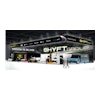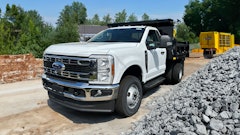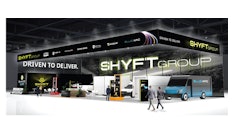
As contractors look to replace vehicles in their fleet, innovation and decarbonization are driving many of the recent offerings in today’s pickup market. For a look at some of the latest offerings, Equipment Today spoke with both Ford Pro’s Kevin Lieberum and Ram Brand’s David Sowers for more information on recent developments and insights on future pickup product lines.
Pickup Trends
Lieberum, Ford Pro F-150 and Lightning brand manager, is not only well acquainted with trucks, but also the construction environment and the concerns of today’s fleet owners. “The trends driving today’s demand for pickups are the same as they always have been — capability, cost of ownership, and technology,” said Lieberum. “We are a nation that works hard and, for those in the trades and running businesses, we’ve developed the most powerful and capable pickups that exist, but we have also created new ways of making business more efficient.”
Today, Ford Pro offers end users heightened features such as Pro Power Onboard, allowing customers to use their truck as a mobile generator. Lieberum also notes that tech features like Ford Pro Software can streamline operations, make daily routines more efficient, and help end users reduce downtime.
Sowers, director of Ram Professional Operations at Stellantis, Ram Brand, who has more than 30 years of truck-centric automotive experience, says customers steadily demand more innovation, technology and safety components in their fleets, noting that the primary concerns of today’s fleet owners are capability and efficiency.
Market Demand
When it comes to general demand, Lieberum says the economic environment greatly influences demand, and the company tends to see truck demand move in sync with GDP, housing starts and other macroeconomic factors. But when it comes to the type of trucks most in demand for construction fleets, heavy-duty seem to top the list. However, every fleet owner’s needs are different and many are looking for versatility in their fleet.
For instance, according to Ford, volumes are high for the Super Duty, since the models span across a wide variety of trims, pickups and chassis cabs to fit different construction use cases and duty cycles. Ford’s range of pickups can be used for industry needs at various levels of work, says Lieberum. “Maverick, Ranger and F-150 are all light duty pickups, Super Duty F-250-450 are Heavy Duty pickups, F-550 is a Class 5 Heavy Duty chassis cab, and F-600 is classified as a Class 6 Medium Duty chassis cab. We also offer larger Medium Duty trucks in the F-650/F-750.”
Ram continues to grow alongside industry demand, says Sowers. “The 2025 Ram 1500 has come a long way as far as capability. The past decade has turned what was once a ‘half-ton’ pickup into a one-ton pickup, with payload capability up to 2,300 pounds. That level of engineering has cascaded through the entire truck with greater efficiency and
technology. The same can be said for the Ram Heavy Duty lineup to a greater extent in capability with payload numbers up to 7,680 pounds.” Sowers notes there are a number of use cases throughout the construction environment, which is why many operators have both light duty and heavy-duty versions. “In many cases, the Ram 1500 serves two jobs: as a work truck [during the week] and family hauler on the weekends,” said Sowers.
Specs, Sizes & Towing
Contractors adding to their fleet face the task of specifying a pickup that fits a variety of needs and, according to Lieberum, they must be able to tailor the truck as a tool to fit those needs.
“Ford offers a variety of configurations when it comes to cab size for worker accommodations and secure tool storage, bed length for payload volume and ease of access, maximum tow rating, axle ratios for towing power versus fuel efficiency, engine, transmission and driveline options for the balance of power and efficiency, and towing technology to make it easier for more employees to hitch up and comfortably tow the trailers they need.”
While there is no shortage of specs or factors to consider, most selections are driven by usage and budget. Lieberum says everything — from cab size, box length, 4x4 needs, axle ratio, payload, towing capacity, and powertrain attributes — need to fit the job at hand. “There is no one-size-fits-all [solution], but we often see customers buying bigger trucks to make sure they have every possible need covered,” said Lieberum. “Sometimes, customers who use telematics are surprised when they look at actual usage data — using tools, like our EV Switch Assist — and find they are able to replace their aging work trucks with new F-150 Lightnings or XL Hybrid powertrains that will not only do the job, but also save them money.”
Sowers stresses the importance of working closely with your dealer to identify the specific needs of your fleet and working to “job rate” your vehicles. “By providing [your dealer] specific usage requirements, they can help spec the right vehicle in terms of gross vehicle weight, payload and trailer towing capability,” said Sowers.
When it comes to trailering needs, says Lieberum, the first thing to consider is the tow rating and other relevant weight ratings, but also towing frequency. “If the truck is towing something very heavy nearly every day, then, typically, that leads to consideration of diesel or higher capability gas powertrains” said Lieberum. “However, if that tow usage is only occasional, then it might be more cost effective to buy a powertrain that is optimal for day-to-day usage but still has the capability to tow that load even if its performance while towing is less than what a larger, more expensive powertrain would have provided.”
Ford offers trailer tow enabling features on all of its trucks, which range from basic equipment — like tow mirrors and trailer brake controllers — to high-tech features like 360-degree cameras with trailer and Pro Trailer Hitch Assist.
Ford’s top-performing heavy-duty truck is the F-450, featuring a 6.7-liter Power Stroke Diesel High Output producing 500 horsepower and 1,200 lb-ft of torque, rear wheel drive configuration, with a single cab and dual rear wheels. “With the proper trailering options, like the Max Tow Package, this pickup is capable of towing 40,000 pounds using a gooseneck hitch” said Lieberum. “This truck is designed for extreme work, towing the largest flatbed or lowboy trailers to move equipment like excavators, telehandlers and bulldozers.”
Lieberum also notes that when it comes to chassis cabs, Ford’s F-600, a Class 6 truck, can be customized with a variety of second unit bodies, including dump bodies or stake beds more in line with pickup usage — though it offers the same cab and interior features as the F-250 through F-450 pickups, despite having a gross vehicle weight rating of 22,000 lbs.
Ram’s most powerful, most capable pickup in the segment, The Ram Heavy Duty, offers a towing capacity of up to 37,090 pounds and a payload capacity of 7,680 pounds. “Ram was the first to achieve the 1,000 lb.-ft. of torque milestone with the Cummins I-6 Turbo Diesel, now rated at 1,075 lb.-ft. of torque,” said Sowers. Along with these capabilities, Sowers says operator comforts are also a priority. “Class-leading ride and handling is accomplished via a class-exclusive link-coil rear (2500) suspension system with optional rear air suspension (2500 and 3500),” said Sowers.
Looking ahead in this segment, Sowers says Ram will be launching its new 25MY 2500 and 3500 pickup trucks in Q1 2025, noting the 25 model will include significant updates in capability, technology and safety.
Powertrain Perspectives
As manufacturers deliver more diverse powertrain options, the optimal powertrain for any one construction fleet is unique to that fleet and should be based on the contractor’s specific needs. Lieberum says key considerations include cost of ownership, regulatory compliance and convenient access to service centers. “Generally,” said Lieberum, “fleet customers tend to buy the standard powertrain unless their needs dictate otherwise in order to optimize their budget.”
“For heavy-duty towing applications, [Ford’s] PowerStroke diesel engine remains highly sought-after,” said Lieberum. “Contractors seeking a balance of payload, towing capacity and cost often opt for the 3.5-liter EcoBoost V6 or 7.3-liter gas V8 engines.”
According to Sowers, “We see traditional gas and diesel powertrains continuing to be the mainstream uses through the end of the decade, but there will be increasing mixes of electrification and ZEVs.”
Lieberum says Ford’s alternative options, PowerBoost Hybrid system and F-150 Lightning Pro, offer unique advantages for jobsites lacking power infrastructure. “These vehicles enable contractors to recharge cordless tools, power corded equipment, and serve as central power sources for entire work areas while minimizing idle fuel consumption,” said Lieberum.
“Most fleets are taking a pragmatic approach to introducing electrification as part of a smaller mix and growing over time,” said Sowers. He also notes that most fleets will mix their powertrains for their specific needs, and electrification is applied where the functional needs can be met.
“For those requiring heavy-duty towing capabilities, diesel engines are the ideal choice,” said Lieberum. “Customers prioritizing a balance of payload, towing capacity, fuel efficiency and affordability often opt for gas-powered models. In terms of specific vehicles, those seeking optimal fuel economy and utility usually gravitate toward the Maverick Hybrid while those looking for significant electrical power for jobsite applications might prefer the F-150 Lightning Pro. In 2024, we switched the base engine on F-150 to the 2.7L Ecoboost and have seen many happy customers appreciate that power and capability.” He also notes the construction industry tends to demand V8 gas F-150s for towing smaller trailers, while the Super Duty pickups come standard with the 6.8L V8 gas engine or optional 7.3L V8 gas engine, which customers tend to prefer when ultimate towing capability is not required.
Lieberum notes that recently, many customers have begun to gravitate toward hybrid or electric vehicles to capitalize on fuel savings and government incentives. Ford Pro now offers E-Switch Assist, a tool that helps businesses assess the suitability of their current Ford vehicles for transitioning to electric options.
On the sustainability front, Ford aims to achieve carbon neutrality by 2050 globally, and 2035 in Europe, focusing on its vehicles, operations and supply chain. Today, the company offers a range of gas, hybrid and electric vehicles to support this goal, giving end users the opportunity to make informed choices on their own path to carbon-neutral transportation.
Ram is aiming for carbon neutrality on a tighter timeline, with a plan to reduce carbon emissions by 50% by 2030 and be entirely carbon neutral by 2038, including the Ram Truck line.
 Ford Pro's F-150 Lightning offers an electric fleet solution with overnight charging that allow you to start the day at a full charge and Pro Power Onboard which turns the truck into a fully-functioning generator.Ford Pro
Ford Pro's F-150 Lightning offers an electric fleet solution with overnight charging that allow you to start the day at a full charge and Pro Power Onboard which turns the truck into a fully-functioning generator.Ford Pro
Technology Features
Within the last decade, technology adoption has boomed as contractors began to see gains in efficiency and productivity driven by data. According to Sowers, “Data usage will be a significant part of improving business efficiency going forward. Today, it amounts to using telematics to improve vehicle efficiency, but the future will integrate the vehicles with the tools and equipment to make an efficient workplace.”
Ford Pro’s Telematics offering delivers key information to end users, including fuel consumption, EV range, idling time, fleet tracking and vehicle health monitoring. Further enhancing these fleet management capabilities, the Ford Pro Telematics Drive app allows remote monitoring, trip detail exports, vehicle checks and remote locking/unlocking.
Ram’s Sowers notes that new technology not only helps to improve vehicle and fleet efficiency, but also steps up resale value, maintenance and reliability. Telematics especially optimizes operations and provides an added layer of protection to fleets.
As Lieberum notes, the integration of Lytx dashcams with Ford Pro Intelligence and Ford commercial vehicles is another layer of technology designed to promote safer driving practices. “Construction customers are recognizing the value of active modems in their vehicles,” said Lieberum, “which enable a range of digital capabilities such as remote security, advanced telematics and remote video. Ford Pro offers complimentary services like Ford Pro Telematics Essentials and E-Telematics to enhance fleet efficiency and security. “
As we look to the future of truck technologies, Lieberum says even more features and benefits will come to market and continue to improve pickup offerings. For example, one of Ford’s new features, Smart Acceleration Truncation on the F-150 Lightning, provides enough power to drive normally, and intelligently adjusts for the load on the truck while not delivering all of the available 775 lb-ft of torque when not needed, to help optimize efficiency and wear and tear on things like tires.
“With our engineers and employees constantly innovating, the potential is limitless to bring future innovations that provide a better product to our customers,” said Lieberum.
According to Sowers, “All future trucks will likely [include] connected platforms to allow telematics, predictive maintenance and repair via over-the-air updates.” And today, the future is appearing much closer than anyone might expect.




















